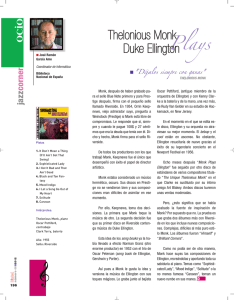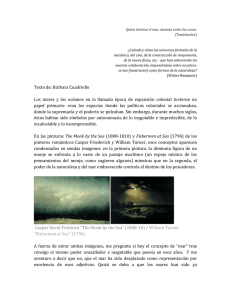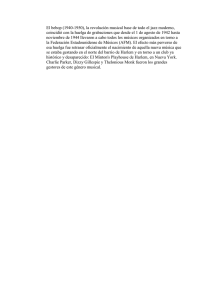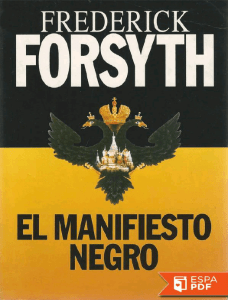THE BERLIN-BASED, British artist Jonathan Monk (Leicester, UK
Anuncio
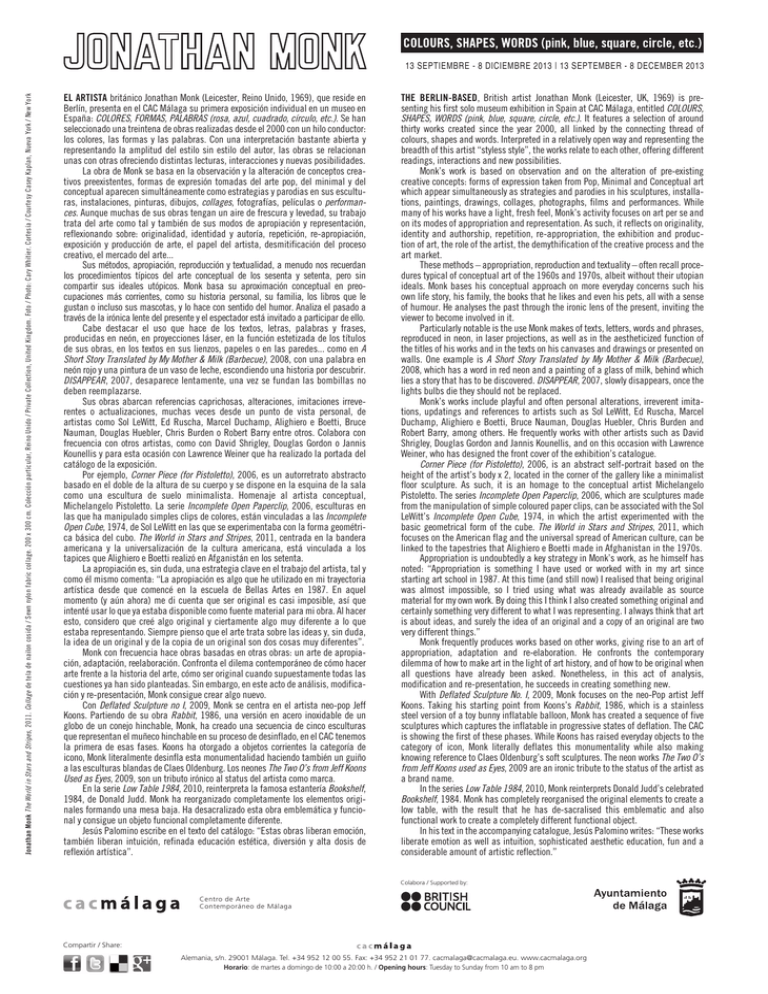
Jonathan Monk The World in Stars and Stripes, 2011. Collage de tela de nailon cosida / Sewn nylon fabric collage. 200 x 300 cm. Colección particular, Reino Unido / Private Collection, United Kingdom. Foto / Photo: Cary Whitier. Cortesía / Courtesy Casey Kaplan, Nueva York / New York 13 SEPTIEMBRE - 8 DICIEMBRE 2013 | 13 SEPTEMBER - 8 DECEMBER 2013 EL ARTISTA británico Jonathan Monk (Leicester, Reino Unido, 1969), que reside en Berlín, presenta en el CAC Málaga su primera exposición individual en un museo en España: COLORES, FORMAS, PALABRAS (rosa, azul, cuadrado, círculo, etc.). Se han seleccionado una treintena de obras realizadas desde el 2000 con un hilo conductor: los colores, las formas y las palabras. Con una interpretación bastante abierta y representando la amplitud del estilo sin estilo del autor, las obras se relacionan unas con otras ofreciendo distintas lecturas, interacciones y nuevas posibilidades. La obra de Monk se basa en la observación y la alteración de conceptos creativos preexistentes, formas de expresión tomadas del arte pop, del minimal y del conceptual aparecen simultáneamente como estrategias y parodias en sus esculturas, instalaciones, pinturas, dibujos, collages, fotografías, películas o performances. Aunque muchas de sus obras tengan un aire de frescura y levedad, su trabajo trata del arte como tal y también de sus modos de apropiación y representación, reflexionando sobre: originalidad, identidad y autoría, repetición, re-apropiación, exposición y producción de arte, el papel del artista, desmitificación del proceso creativo, el mercado del arte... Sus métodos, apropiación, reproducción y textualidad, a menudo nos recuerdan los procedimientos típicos del arte conceptual de los sesenta y setenta, pero sin compartir sus ideales utópicos. Monk basa su aproximación conceptual en preocupaciones más corrientes, como su historia personal, su familia, los libros que le gustan o incluso sus mascotas, y lo hace con sentido del humor. Analiza el pasado a través de la irónica lente del presente y el espectador está invitado a participar de ello. Cabe destacar el uso que hace de los textos, letras, palabras y frases, producidas en neón, en proyecciones láser, en la función estetizada de los títulos de sus obras, en los textos en sus lienzos, papeles o en las paredes... como en A Short Story Translated by My Mother & Milk (Barbecue), 2008, con una palabra en neón rojo y una pintura de un vaso de leche, escondiendo una historia por descubrir. DISAPPEAR, 2007, desaparece lentamente, una vez se fundan las bombillas no deben reemplazarse. Sus obras abarcan referencias caprichosas, alteraciones, imitaciones irreverentes o actualizaciones, muchas veces desde un punto de vista personal, de artistas como Sol LeWitt, Ed Ruscha, Marcel Duchamp, Alighiero e Boetti, Bruce Nauman, Douglas Huebler, Chris Burden o Robert Barry entre otros. Colabora con frecuencia con otros artistas, como con David Shrigley, Douglas Gordon o Jannis Kounellis y para esta ocasión con Lawrence Weiner que ha realizado la portada del catálogo de la exposición. Por ejemplo, Corner Piece (for Pistoletto), 2006, es un autorretrato abstracto basado en el doble de la altura de su cuerpo y se dispone en la esquina de la sala como una escultura de suelo minimalista. Homenaje al artista conceptual, Michelangelo Pistoletto. La serie Incomplete Open Paperclip, 2006, esculturas en las que ha manipulado simples clips de colores, están vinculadas a las Incomplete Open Cube, 1974, de Sol LeWitt en las que se experimentaba con la forma geométrica básica del cubo. The World in Stars and Stripes, 2011, centrada en la bandera americana y la universalización de la cultura americana, está vinculada a los tapices que Alighiero e Boetti realizó en Afganistán en los setenta. La apropiación es, sin duda, una estrategia clave en el trabajo del artista, tal y como él mismo comenta: “La apropiación es algo que he utilizado en mi trayectoria artística desde que comencé en la escuela de Bellas Artes en 1987. En aquel momento (y aún ahora) me di cuenta que ser original es casi imposible, así que intenté usar lo que ya estaba disponible como fuente material para mi obra. Al hacer esto, considero que creé algo original y ciertamente algo muy diferente a lo que estaba representando. Siempre pienso que el arte trata sobre las ideas y, sin duda, la idea de un original y de la copia de un original son dos cosas muy diferentes”. Monk con frecuencia hace obras basadas en otras obras: un arte de apropiación, adaptación, reelaboración. Confronta el dilema contemporáneo de cómo hacer arte frente a la historia del arte, cómo ser original cuando supuestamente todas las cuestiones ya han sido planteadas. Sin embargo, en este acto de análisis, modificación y re-presentación, Monk consigue crear algo nuevo. Con Deflated Sculpture no I, 2009, Monk se centra en el artista neo-pop Jeff Koons. Partiendo de su obra Rabbit, 1986, una versión en acero inoxidable de un globo de un conejo hinchable, Monk, ha creado una secuencia de cinco esculturas que representan el muñeco hinchable en su proceso de desinflado, en el CAC tenemos la primera de esas fases. Koons ha otorgado a objetos corrientes la categoría de icono, Monk literalmente desinfla esta monumentalidad haciendo también un guiño a las esculturas blandas de Claes Oldenburg. Los neones The Two O’s from Jeff Koons Used as Eyes, 2009, son un tributo irónico al status del artista como marca. En la serie Low Table 1984, 2010, reinterpreta la famosa estantería Bookshelf, 1984, de Donald Judd. Monk ha reorganizado completamente los elementos originales formando una mesa baja. Ha desacralizado esta obra emblemática y funcional y consigue un objeto funcional completamente diferente. Jesús Palomino escribe en el texto del catálogo: “Estas obras liberan emoción, también liberan intuición, refinada educación estética, diversión y alta dosis de reflexión artística”. THE BERLIN-BASED, British artist Jonathan Monk (Leicester, UK, 1969) is presenting his first solo museum exhibition in Spain at CAC Málaga, entitled COLOURS, SHAPES, WORDS (pink, blue, square, circle, etc.). It features a selection of around thirty works created since the year 2000, all linked by the connecting thread of colours, shapes and words. Interpreted in a relatively open way and representing the breadth of this artist “styless style”, the works relate to each other, offering different readings, interactions and new possibilities. Monk’s work is based on observation and on the alteration of pre-existing creative concepts: forms of expression taken from Pop, Minimal and Conceptual art which appear simultaneously as strategies and parodies in his sculptures, installations, paintings, drawings, collages, photographs, films and performances. While many of his works have a light, fresh feel, Monk’s activity focuses on art per se and on its modes of appropriation and representation. As such, it reflects on originality, identity and authorship, repetition, re-appropriation, the exhibition and production of art, the role of the artist, the demythification of the creative process and the art market. These methods – appropriation, reproduction and textuality – often recall procedures typical of conceptual art of the 1960s and 1970s, albeit without their utopian ideals. Monk bases his conceptual approach on more everyday concerns such his own life story, his family, the books that he likes and even his pets, all with a sense of humour. He analyses the past through the ironic lens of the present, inviting the viewer to become involved in it. Particularly notable is the use Monk makes of texts, letters, words and phrases, reproduced in neon, in laser projections, as well as in the aestheticized function of the titles of his works and in the texts on his canvases and drawings or presented on walls. One example is A Short Story Translated by My Mother & Milk (Barbecue), 2008, which has a word in red neon and a painting of a glass of milk, behind which lies a story that has to be discovered. DISAPPEAR, 2007, slowly disappears, once the lights bulbs die they should not be replaced. Monk’s works include playful and often personal alterations, irreverent imitations, updatings and references to artists such as Sol LeWitt, Ed Ruscha, Marcel Duchamp, Alighiero e Boetti, Bruce Nauman, Douglas Huebler, Chris Burden and Robert Barry, among others. He frequently works with other artists such as David Shrigley, Douglas Gordon and Jannis Kounellis, and on this occasion with Lawrence Weiner, who has designed the front cover of the exhibition’s catalogue. Corner Piece (for Pistoletto), 2006, is an abstract self-portrait based on the height of the artist’s body x 2, located in the corner of the gallery like a minimalist floor sculpture. As such, it is an homage to the conceptual artist Michelangelo Pistoletto. The series Incomplete Open Paperclip, 2006, which are sculptures made from the manipulation of simple coloured paper clips, can be associated with the Sol LeWitt’s Incomplete Open Cube, 1974, in which the artist experimented with the basic geometrical form of the cube. The World in Stars and Stripes, 2011, which focuses on the American flag and the universal spread of American culture, can be linked to the tapestries that Alighiero e Boetti made in Afghanistan in the 1970s. Appropriation is undoubtedly a key strategy in Monk’s work, as he himself has noted: “Appropriation is something I have used or worked with in my art since starting art school in 1987. At this time (and still now) I realised that being original was almost impossible, so I tried using what was already available as source material for my own work. By doing this I think I also created something original and certainly something very different to what I was representing. I always think that art is about ideas, and surely the idea of an original and a copy of an original are two very different things.” Monk frequently produces works based on other works, giving rise to an art of appropriation, adaptation and re-elaboration. He confronts the contemporary dilemma of how to make art in the light of art history, and of how to be original when all questions have already been asked. Nonetheless, in this act of analysis, modification and re-presentation, he succeeds in creating something new. With Deflated Sculpture No. I, 2009, Monk focuses on the neo-Pop artist Jeff Koons. Taking his starting point from Koons’s Rabbit, 1986, which is a stainless steel version of a toy bunny inflatable balloon, Monk has created a sequence of five sculptures which captures the inflatable in progressive states of deflation. The CAC is showing the first of these phases. While Koons has raised everyday objects to the category of icon, Monk literally deflates this monumentality while also making knowing reference to Claes Oldenburg’s soft sculptures. The neon works The Two O’s from Jeff Koons used as Eyes, 2009 are an ironic tribute to the status of the artist as a brand name. In the series Low Table 1984, 2010, Monk reinterprets Donald Judd’s celebrated Bookshelf, 1984. Monk has completely reorganised the original elements to create a low table, with the result that he has de-sacralised this emblematic and also functional work to create a completely different functional object. In his text in the accompanying catalogue, Jesús Palomino writes: “These works liberate emotion as well as intuition, sophisticated aesthetic education, fun and a considerable amount of artistic reflection.” Colabora / Supported by: Centro de Arte Contemporáneo de Málaga Compartir / Share: Alemania, s/n. 29001 Málaga. Tel. +34 952 12 00 55. Fax: +34 952 21 01 77. cacmalaga@cacmalaga.eu. www.cacmalaga.org Horario: de martes a domingo de 10:00 a 20:00 h. / Opening hours: Tuesday to Sunday from 10 am to 8 pm
